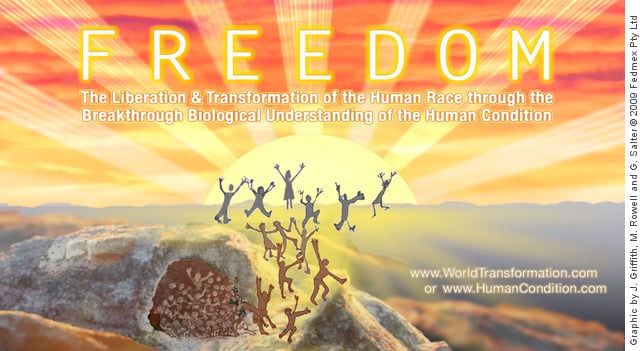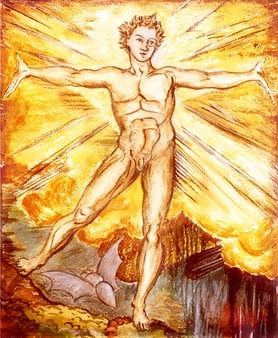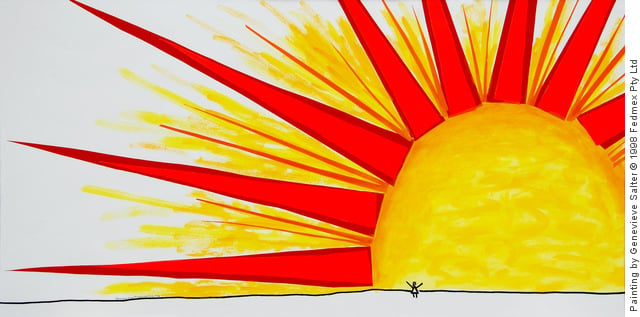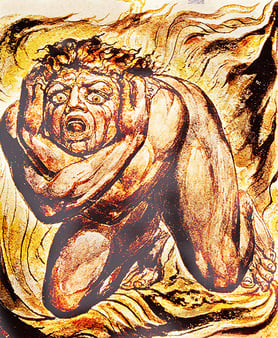Freedom Expanded: Book 1—The Human Condition Explained
Part 3:5 We can now know that not only are humans good, we are the absolute heroes of the story of life on Earth

The WTM’s FREEDOM poster, copies of which are freely available at <www.humancondition.
It is not surprising then that, unable to explain ourselves and, in doing so, safely acknowledge the truth of our own instinctive orientation, and other previously unconfrontable truths, denial—and deep denial at that—has been our only means of coping with the imperfections and dilemmas of our lives.
As will be described more fully in Part 3:10, in his great work, The Republic, the Greek philosopher Plato (c.429-347 BC) employed the allegory of a cave to describe the human condition. This allegory—in which humans live imprisoned in a dark cave, deep underground (which the picture of the cave in our FREEDOM poster, above, depicts)—is the perfect metaphor for having to live in a state of denial or block-out or dissociation or alienation: humans have had to, as it were, hide in a cave to avoid the glaring light of the sun, which symbolises all the truth about ourselves that we haven’t, until now, been able to confront. Indeed, while some of those unbearable truths have been introduced, as this presentation progresses more and more truths that we have had to live in denial of will be revealed, which will undoubtedly make the reader/viewer nervous, however, all these truths will be presented under the umbrella of the safety of the dignifying, reconciling, redeeming, rehabilitating and TRANSFORMING full truth about our less-than-ideal, imperfect, upset, hurt, damaged, compromised, corrupted, soul-destroyed lives. Explanation of the human condition brings ameliorating, healing understanding to all the upset, all the psychological suffering in human life. The word ‘psychiatry’ literally means ‘soul-healing’ (derived as it is from psyche meaning ‘soul’ and iatreia meaning ‘healing’), but we have never been able to ‘heal our soul’, explain to our original instinctive self or soul that we, our fully conscious, thinking self is good and not bad and, by so doing, reconcile and heal our split selves—until now.
As the euphemisms have asserted, ‘understanding is compassion’, ‘the truth will set you free’ (Bible, John 8:32), ‘honesty is therapy’ and ‘in repentance lies salvation’—but we humans have never been able to ‘understand’ ourselves, know ‘the truth’ about ourselves, be ‘honest’ about our condition, explain why we have been upset and in so doing end our insecurity and redeem ourselves from upset with honesty. But now we can. Now that we can explain and understand that we are fundamentally good and not bad after all, the insecure, suicidally depressing state of our apparently contradictory nature—our human condition—can be reconciled and thus brought to an end. As Professor Prosen said, with understanding of the human condition found ‘the psychological rehabilitation of the human race’ can finally begin.
I mentioned earlier that the Adam Stork analogy has parallels to the Biblical account presented in Genesis of the story of the Garden of Eden, in which Adam and Eve ‘eat [the fruit] from the tree of the knowledge of good and evil’ (2:17) that was ‘desirable for gaining wisdom’ (3:6)—go in search of understanding—and, as a result, are demonised and ‘banished…from the Garden of Eden’ (3:23). In short, when we went in search of understanding our upset, corrupted, ‘fallen’ (derived from the title of Gen. 3, ‘The Fall of Man’), supposedly ‘sinful’, ‘guilty’ state emerged. However, in this presentation, as in the Adam Stork analogy, Adam and Eve are not the banishment-deserving, evil, worthless, guilty villains they are portrayed as in Genesis, but immense HEROES, for they, representing, as they do, all humans, had to go in search of knowledge and defy ignorance. But since our instincts had no sympathy for the pursuit of knowledge and would have stopped the search if possible, defiance of those instincts and the upset that resulted was the price we had to pay to find understanding. It couldn’t have been any other way.
We fully conscious humans had to set out in search for knowledge, we had to have the courage to bite into the proverbial ‘apple’, which is why ‘apple’, and the symbol of an apple with a bite out of it, are such inspired branding choices for the information communication and technology giant, Apple Inc. It is also why I drew a version of the apple for the logo of WTM Publishing & Communications, the organisation that now publishes all of our books and other publications.
So at last we humans are now able to understand that greatest of all paradoxes of how we could be good when, by all appearances, we seem to be bad, evil, guilty, sinful, defiling, undeserving, worthless creatures. In fact, we can see now that we fully conscious humans are not just good, we are the absolute heroes of the story of life on Earth for having endured so much unjust criticism for so long before we were able to prevail over that criticism and explain why it wasn’t deserved.
We can now understand why our intellect, surely the culminating achievement of the grand experiment in nature that we call life, also appeared to be the most destructive, even evil, force to have ever appeared on Earth. Our previous inability to explain this dichotomy, to explain all the corrupting and destructive repercussions of being—supposedly—the most brilliant, fully conscious, highly intelligent, super-smart, rational animal on the planet, has meant that we humans have been extremely insecure and defensive about our supposedly brilliant intelligence. After all, what was so smart and intelligent and rational about being so brutal as to create a world of suffering, and so destructive as to nearly destroy the planet we live on? As described in Genesis, our fully conscious, self-adjusting intellect caused us to take the ‘fruit’ ‘from the tree of…knowledge’ and become so badly behaved and destructive that we seemingly deserved to be condemned and ‘banished’ as defiling, unworthy, evil beings. But now that we can understand that our intellect was simply fulfilling its great potential to be the knowing master of change (as opposed to all other forms of life that are the unknowing victims of change) and having to do so in the condemning presence of an unjustly critical instinctive self, we can at last face the truth about the role our intellect has been playing and finally appreciate why such destruction was a tragic but unavoidable by-product of that process. Our intellect’s readiness to stoically endure and persevere in a situation where it has been unjustly condemned as the great evil influence on Earth, and to have endured that horrific persecution for some two million years, reveals our intellect to have been the very opposite of the villain in the story of life on Earth—it has been the absolute hero of that saga. We can see in hindsight that we were living in denial of a partial or half truth—denying that our intellect appeared to be the guilty party behind all the destruction going on in the world—until we found the full, compassionate and redeeming truth that would explain that our intellect was not the villain but the hero. A denial that said we weren’t bad was less of a lie than a partial truth that implied we were.
For two million years our intellect has been seen as the villain of the piece while our instinctive self or soul’s moral conscience was held up as the epitome of goodness, but the truth, which we can now finally explain, turns out to be the exact opposite in the sense that it was our instincts’ unjust criticism that caused us to become upset. This paradoxical turn of events in which our ‘good side’ is revealed to have been the ‘bad side’ is the theme of the English crime writer (and, according to the Guinness Book of World Records, the all time best-selling writer of books) Agatha Christie’s famous play The Mousetrap. First performed in 1952, The Mousetrap is just another ‘whodunnit’ murder mystery and yet it is now the longest running play in history—and it’s still going strong, celebrating its 60th anniversary with a global tour in 2012. All enduring myths and stories contain truths that resonate, and in the case of The Mousetrap, the police inspector involved in the murder investigation, who is held up as the pillar of goodness and justice throughout the play, is revealed at the very end of the play to be the culprit. It is the essential story of humanity where the apparent ideals of the soul’s selfless, loving world are revealed, at the very last moment, to have been the unjustly condemning villains. As with so many aspects of the human condition, the truth was not as it appeared. We discover at the very end of our journey to enlightenment that conscious humans, immensely corrupt as we are, are good and not bad after all. In fact, not only are we good, we are the absolute heroes of the whole horrible tragedy.
In the English writer G.K. Chesterton’s 1908 book The Man Who Was Thursday, a policeman representing the ‘good’ side has to infiltrate and expose the sinister members of a quintessentially corrupt organisation, but consecutively each of the apparently corrupt members are revealed to be forces for good commissioned to fight evil. Again, it is a story of the essential paradox of the human situation: that which was apparently ‘bad’—humans in our competitive and divisive state—turns out to be ‘good’, and that which was ‘good’ turns out to be the cause of our ‘sin’.
With understanding of the issue of the human condition now found the great, ancient, historical, debilitating burden of guilt has finally been lifted from our species’ shoulders. While we fully conscious intelligent humans always intuitively believed we weren’t fundamentally bad and evil, we could never explain why we weren’t, but now at last we can. Unable to explain ourselves we were condemned to living life in a tortured, cave-like state of alienating denial, but the human race can now come home from that deathly dark cave-like existence it was forced to live in and stand FREE in the sunshine of dignifying, uplifting, relieving, redeeming, explaining and liberating self-knowledge. It is all over. Our banishment from THE HELL OF UNJUST CONDEMNATION HAS ENDED. WE HUMANS ARE FREE AT LAST—WE ARE FREE AT LAST—WE ARE COMING HOME.
The American lyricist Joe Darion encapsulated this great paradox of the human condition in his 1965 song, The Impossible Dream (which featured in the musical The Man of La Mancha), when he wrote that we had to be prepared ‘to march into hell for a heavenly cause’; we had to lose ourselves, suffer self-corruption, in order to find ourselves. Upset was the price of our heroic search for knowledge. And ‘upset’ is the right word because while we are not ‘bad’ we are definitely upset. ‘Corrupted’ and ‘fallen’ have been used but they have negative connotations which we can now understand are not deserved. We humans are now immensely psychologically upset—angry, egocentric and alienated—from participating in humanity’s heroic search for knowledge, but we are not bad, evil beings. In fact, now that we have understanding of the great and necessary battle that humanity had to wage, the whole concept of ‘good’ and ‘evil’, of superior and inferior, disappears from the conceptualisation of ourselves.
Greek mythology described how Prometheus stole fire from his fellow Gods and gave it to humans for their use, an act which enraged the Gods, in particular Zeus who saw that it heralded an era of enlightenment for humans. As punishment, Zeus had Prometheus strapped to the top of a mountain where, every day in perpetuity, Prometheus was forced to suffer having his innards eaten out by an eagle. In light of what has been revealed thus far, we can now understand that in this story fire is the metaphor for the conscious intellect (as it is in many mythologies), and that the consequence of humans gaining a conscious mind was extremely upset behaviour, which explains why Prometheus was punished by the Gods—in their eyes he was responsible for the corruption of the human race, for our falling out with the Godly ideals.
The eighteenth century English poet and philosopher Samuel Taylor Coleridge similarly recognised the suffering that came with our conscious search for understanding, ultimately self-understanding, when he wrote of becoming a ‘sadder and a wiser man [people]’ (The Rhyme of the Ancient Mariner, 1797) as a result of our journey.
But the origin of so-called ‘sin’ has finally been explained and it is science that has made this possible because, after centuries of discovery, science was able to reveal that while the gene-based learning system can give species orientations only the nerve-based learning system is capable of insightful reasoning, and therein lies the explanation of the human condition. One of the products the FHA/WTM has been selling since the early 1990s is a t-shirt that, on the front, poses the question, ‘Ask me to explain the human condition’, under which is the Adam Stork picture. Written on the back is the answer: ‘Genes Can Orientate But Are Ignorant Of Nerves’ Need To Understand. Result: The Human Condition.’ To recap this very important point, it was science’s discovery of the existence of nerves and genes and how they work that enabled the human condition to be explained.
Thus, in summary, if our fully conscious brain is nature’s greatest invention and humans were in effect given the task of developing it then the condemnation, the persecution we have stoically endured for some two million years, the period of time humans have been a fully conscious species, is quite phenomenal—we must surely be the most heroic species to have ever existed on this planet. But it follows that to endure so much unjust condemnation we must have employed a strong mechanism to cope—and we did: as mentioned at the start of this Part, denial has been our only means of coping with the horrific injustice of being unfairly condemned as bad and evil when deep within ourselves we knew we weren’t. Indeed, we have been living in such deep denial of so many truths that we are now the most alienated of species. So much so, in fact, that if advanced intelligent life does exist within the universe, Earth would undoubtedly be known as ‘the planet of the alienated’. But the extent of our alienation is just a measure of how utterly courageous we have had to be in the face of so much unjust condemnation, so while our extreme alienation would be recognised by any foreign intelligent life, so would our incredible bravery.
So despite all appearances to the contrary—despite our anger, egocentricity and alienation—we humans are the most wonderful beings. In fact, if there is a word such as divine that can be applied to mortals, then we can now see that it truly does belong to us—because to withstand two million years of the injustice that we have had to endure and still be on our feet, still be able to laugh, still be able to smack each other on the back with encouragement, still be able to carry on, get out of bed each day and face life under the duress of the human condition, we must be the most magnificent of organisms.
This fact of our magnificence, that we can now understand and know is true rather than merely hope it is so, brings such intense relief to our angst-ridden cells, limbs and torsos that we will find it is like throwing off a shroud of heavy chains. This explanation, which the analogy of Adam Stork depicts, brings so much relieving understanding to the human situation that it ends all the hurt, heartache and suffering; indeed, as this presentation progresses we will see how this explanation of the human condition finally reconciles all the unresolved polarities of the human situation—of instinct and intellect, ‘good’ and ‘evil’, women and men, young and old, left-wing and right-wing, idealism and realism, socialism and capitalism, religion and science, etc, etc.
This is a detail from The Creation of Adam, Michelangelo’s famous masterpiece that adorns the ceiling of the Sistine Chapel in the Vatican City. In interpretations of the painting, God is said to be in the process of creating Adam, yet it can also be construed as God and man reaching out to each other. Since we can now afford to acknowledge that ‘God’ is the personification of the integrative, cooperative, selfless, harmonious ideal values of life, then with the reconciling understanding of our less-than-ideal, human-condition-afflicted state found, the ‘out-stretched fingers’ of God and man have finally touched. It turns out that for all their wild, off-the-wall, upset behaviour, the Blues Brothers really were ‘on a mission from God’ (from the 1980 American film The Blues Brothers); indeed, the life of every human who has ever lived has been entirely meaningful.
We can now see that the story of the human race is the greatest, most heroic story ever told. It is the story of our species’ journey from a pre-conscious state of untroubled ignorance, to conscious awakening and with it the emergence of the horror and darkness of the ‘good and evil’, human-condition-afflicted state, to finally finding the redeeming understanding of that condition. It has been a truly horrendous saga. The suffering, however, has not been in vain because with this dignifying, uplifting, relieving, psychologically-healing, peace-bringing understanding humanity now begins an absolutely fabulous, TRANSFORMED existence.

William Blake’s Albion Arose (c. 1794-96); this coloured impression of Albion Arose was painted by Carol Marando for the WTM in 1991
These famous pictures by the English painter and poet William Blake are reproduced on the cover of two of my books. The painting titled Cringing in Terror is a perfect depiction of the terror of the human condition. In truth, the fiery hell that features in so many of our mythologies, in art and in literature, was not some deathly dark destination we were cast into after living an evil life, it was the horror of the burning state of unbearable condemnation that we humans experienced during our lifetime. Hell has been the existing state of human life. The other picture, titled Albion Arose, perfectly portrays the liberated state that understanding of the human condition makes possible. We can even see a bat flying out from the cave of terrible alienation from which we emerge in a sunlit, rehabilitated, TRANSFORMED state.

Genevieve’s Sun poster, copies of which are freely available at <www.humancondition.
This picture of a tiny figure standing with upraised arms in front of an immense sun as it rises over the horizon represents this fabulous moment of liberation from the human condition. Created by WORLD TRANSFORMATION MOVEMENT founding member Genevieve Salter in January 1998, this image has become the emblem of the WTM and the basis of these posters that form the backdrop of our theatre. It is the scale of the person compared with the size of the rising sun that is so wonderful because it shows just how truly magnificent the arrival of the liberating truth that drives away all the darkness from our lives is.





